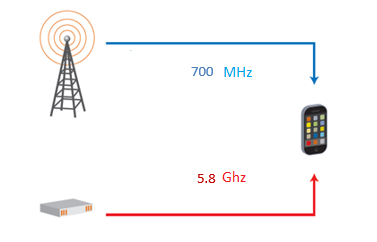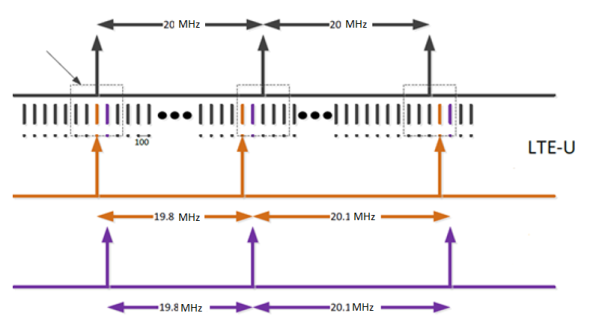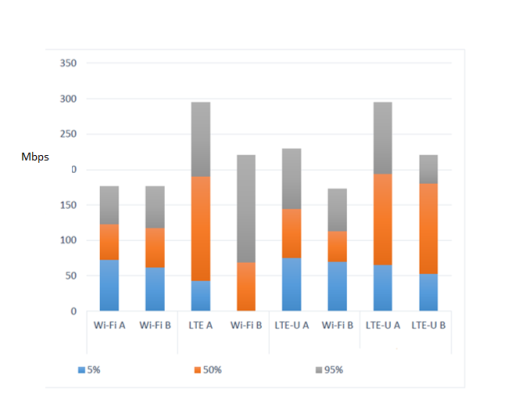This article discusses the basic principles for the operation of Long Term Evolution (LTE) technology in the non-licensed frequency band. The main mechanisms of work are presented and the problems of implementation of this technology are affected.
Keywords: mobile networks, LTE, LTE-U, Wi-Fi, frequency division.
LTE-U (Long Term Evolution in unlicensed spectrum) is a radio access technology that was proposed to provide wireless services in the unlicensed 5 GHz frequency band [1, p. 7]. Until now, Wi-Fi (WLAN, which uses the IEEE 802.11 standard) remains the most popular protocol for radio access in unlicensed space. However, over time, ideas emerged to develop LTE technology, originally developed for the operation of cellular communications in a strictly licensed frequency spectrum, in an unlicensed spectrum, as a way to increase Wi-Fi performance. The main advantages for LTE-U at Wi-Fi frequencies, as a technological basis for better performance, are media access control, mobility management and a significant amount of coverage.

Fig. 1. The general principle of operation of LTE-U
- Theory
Since Wi-Fi devices are already widely distributed in the unlicensed 5 GHz band, there is a need for LTE-U Small Cell (SC) for proper interaction with the Wi-Fi system. In addition, various LTE-U operators may occupy the same spectrum in an unlicensed group in order to provide data transfer services to their users. Such an unplanned and unmanaged deployment of LTE-U SC (femto, picocell) can lead to excessive RF interference in the vicinity of the existing Wi-Fi channel and other nodes of the LTE-U operator. Therefore, it is crucial for LTE-U SC to select the best operational channel with the least possible degree of interference caused by neighboring Wi-Fi and LTE-U networks.
- Problem Statment
However, there are cases where all available channels are occupied by Wi-Fi devices, which force LTE-U SC to work on the same channel as Wi-Fi. Wi-Fi devices do not distort the detected LTE-U signal if its interference level is not higher than the energy detection threshold (−62 dBm in the band greater than 20 MHz). Without proper regulatory mechanisms, LTE-U emissions can cause significant interference on a Wi-Fi network.
The existing LTE uses channel spacing of 100 kHz [2, p. 38]. However, this is a serious problem, as the search space is too large. It is advisable to change the spacing of the LTE-U channel with a Wi-Fi channel to 20 MHz. In addition to these carrier frequencies, it is necessary to provide additional carrier channel spacing of approximately 20 MHz, which will allow alignment of the subcarriers where the carrier frequency separation should be a multiple of 300 kHz according to the current specification.

Fig.2. Frequency resolution by channels
- Results
The full benefits of an LTE-U system generally consist of two internal system design features.
First, LTE control channels are designed for wide coverage and high reliability in a work environment limited by interference. Coverage and reliability are achieved by minimizing and compressing bits of control information and lower coding levels. Thus, the reliability and wider coverage of control channels allow the LTE-U system to operate with a large number of mobile users and achieve greater traffic load.
Secondly, LTE physical data transfer channels and protocols are designed so that it is possible to process data in an unknown radio environment and recover information correctly even in the face of adverse interference. LTE data flow can be encoded with a high level of channel code (for example, 1/3), while the lowest coding level for Wi-Fi traffic is 1/2. In addition, when decoding data over LTE is incorrect, then the received signals are buffered in the LTE UE and combined with later re-transmission to use improved decoding performance. This hybrid automatic retransmission request (HARQ) improves retransmission performance by several dB, as compared to simple automatic retransmission request (ARQ) — a protocol in the Wi-Fi system [3, p. 187].
One of the defining parameters of the comparison of the two technologies was the assessment of bandwidth at 5 %, 50 % and 95 % load by users. As can be seen from the diagram, with the same load by users of LTE-U and Wi-Fi systems, high speeds are achieved by the LTE-U system.

Fig.3. Bandwidth Analysis Results
It is worth noting that LTE-U is designed to improve the efficiency of the LTE radio interface in the non-licensed frequency band in order to provide stable control and higher spectral efficiency while not interfering with Wi-Fi networks.
Initially, Qualcomm, the world's largest chip maker for smartphones and tablets, offered a technology that will help provide mobile networks with the necessary bandwidth. And as an example of implementation, we can mention the South Korean operator LG U +, which showed LTE-U with support for speeds up to 600 Mbps on a commercial network. For the experiment, 60 MHz (3x20 MHz) channels were aggregated in the not licensed 5.8 GHz and 20 MHz bands in the standard LTE band (1.8 GHz). The company plans to expand the aggregated bandwidth in the range of 5.8 GHz to 80 MHz, which will provide the ability to support peak speeds of up to 750 Mbit / s.
- Conclusion
Thus, we have considered only the most basic points that we should pay attention to when analyzing and designing LTE-U systems. However, even a brief listing of the basic principles of technology gives reason to seriously reflect on the implementation. And of course, it should be noted that, over time, the increase in consumer demand, the increase in the number of subscribers, the need for higher speeds will only increase the relevance of the use of technology, with the application of new principles, new mechanisms that will solve the tasks of the end user.
References:
- LTE-U forum, LTE-U Technical Report. Alcatel-Lucent, Ericsson, Qualcomm Technologies Inc., Samsung Electronics & Verizon, 2015, — 44 pp.
- Гельгор А. Л. Технология LTE мобильной передачи данных: учеб. пособие. — СПб.: Изд-во Политехн. ун-та, 2011. — 204 с.
- Ипатов В. П., Орлов В. К. Системы мобильной связи: учебное пособие для вузов. — М.: Изд-во Горячая линия–телеком, 2003.– 272 с.







